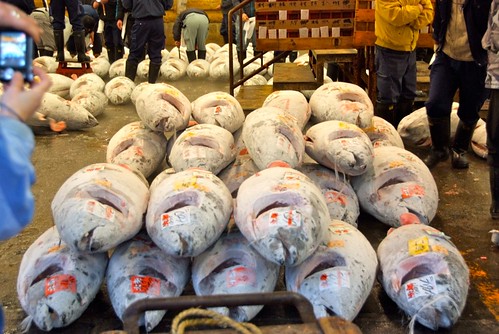зӮәдҝқиӯ·еҲ©жҪӨй«ҳгҖҒеҝ«иў«жҚ•ж’Ҳж®ҶзӣЎзҡ„и—Қй°ӯй®ӘйӯҡпјҢ第11еұҶдёӯиҘҝеӨӘе№іжҙӢжјҒжҘӯ委員жңғпјҲWCPFCпјүжңғиӯ°жңҹй–“пјҢеӨӘе№іжҙӢ33еҖӢжҲҗе“ЎжјҒжҘӯеңӢиҲҮй ҳеңҹж–ј2ж—ҘйҒ”жҲҗе…ұиӯҳпјҢеҚ”иӯ°еҜҰж–Ҫж–°зҡ„и—Қй°ӯй®ӘдҝқиӮІиҰҸзҜ„гҖӮ
дё–з•ҢжңҖеӨ§зҡ„й®Әйӯҡ еӨӘе№іжҙӢ33еңӢеҡҙиЁӮжҚ•ж’Ҳй…ҚйЎҚ
委員жңғзҡ„科еӯёйЎ§е•ҸиЎЁзӨәпјҢеӨӘе№іжҙӢи—Қй°ӯй®ӘйӯҡеҸӘеү©дёӢйҒҺеҺ»ж•ёйҮҸзҡ„4%гҖӮдё–з•ҢиҮӘ然еҹәйҮ‘жңғпјҲWWFпјүдёӯиҘҝеӨӘе№іжҙӢй®ӘйӯҡиЁҲеҠғ經зҗҶAlfred CookиЈңе……пјҢж•ҙеҖӢйӯҡзҫӨж•ёйҮҸеҸӘеү©дёӢдёҖе°ҸзҫӨе№ҙдәӢе·Ій«ҳзҡ„з№Ғж®–ж—ҸзҫӨз¶ӯ繫著гҖӮ
и—Қй°ӯй®ӘйӯҡжҳҜе…Ёдё–з•ҢжңҖеӨ§зҡ„й®ӘйӯҡпјҢеЈҪе‘ҪеҸҜйҒ”40е№ҙгҖӮзү еҖ‘еңЁеҗ„еӨ§жҙӢд№Ӣй–“йҒ·еҫҷпјҢжҙ»еӢ•ж·ұеәҰеҸҜйҒ”и¶…йҒҺ4,000иӢұе°әгҖӮз”ұж–је…Ёзҗғз”ҹйӯҡзүҮеёӮе ҙзҡ„йңҖжұӮпјҢеӨӘе№іжҙӢи—Қй°ӯй®ӘйӯҡжӢҚиіЈеғ№ж јзӣёз•¶й«ҳпјҢе°Өе…¶жҳҜж—Ҙжң¬еёӮе ҙпјҢе…Ёзҗғ80%жҚ•ж’ҲеҲ°зҡ„и—Қй°ӯй®ӘйӯҡжңҖеҫҢиў«ж—ҘдәәеҗғдёӢиӮҡгҖӮ
ж–°зҡ„дҝқиӮІиҰҸзҜ„иҰҒжұӮпјҢжјҒиҲ№жҚ•ж’ҲйҮҸеҝ…й ҲеңЁ2002е№ҙиҮі2004е№ҙзҡ„е№іеқҮж°ҙжә–д»ҘдёӢгҖӮ30е…¬ж–Өд»ҘдёӢзҡ„й®ӘйӯҡжҚ•ж’ҲйҮҸеҝ…й Ҳжёӣе°‘иҮі2002е№ҙиҮі2004е№ҙе№іеқҮзҡ„50%гҖӮеҰӮжһңи¶…йҒҺйҷҗеҲ¶пјҢеҝ…й Ҳеҫһйҡ”е№ҙзҡ„жҚ•ж’ҲйҷҗйЎҚжүЈйҷӨи¶…еҮәйғЁеҲҶгҖӮ
еӨ§иҘҝжҙӢи—Қй°ӯй®Әд№ҹзҖ•еҚұ еӯёиҖ…иӯҰе‘ҠеӢҝйҒҺеәҰжЁӮи§Җ
и—Қй°ӯй®Әйӯҡжңү3зЁ®пјҡй«”еһӢжңҖеӨ§д№ҹжңҖзҖ•еҚұзҡ„жҳҜеӨ§иҘҝжҙӢи—Қй°ӯй®ӘпјҢйӮ„жңүеӨӘе№іжҙӢе’ҢеҚ—жҙӢи—Қй°ӯй®ӘгҖӮеӨ§иҘҝжҙӢи—Қй°ӯй®ӘеӨ§еӨҡжҚ•ж’ҲиҮӘең°дёӯжө·пјҢжҳҜе…Ёдё–з•ҢжңҖйҮҚиҰҒзҡ„и—Қй°ӯй®ӘжјҒе ҙгҖӮеңЁеӨ§иҘҝжҙӢе’Ңең°дёӯжө·пјҢи—Қй°ӯй®Әзҡ„еӯҳзәҢзӢҖжіҒжӣҙеҠ еҚұжҖҘгҖӮ
11жңҲ17ж—ҘпјҢеӨ§иҘҝжҙӢй®ӘйЎһдҝқиӮІе§”е“ЎжңғпјҲICCATпјүеңЁзҫ©еӨ§еҲ©зҶұйӮЈдәһзҡ„жңғиӯ°дёҠпјҢеӨ§е№…еҗҢж„ҸеўһеҠ ең°дёӯжө·и—Қй°ӯй®ӘжҚ•ж’Ҳй…ҚйЎҚгҖӮеӨ§иҘҝжҙӢе’Ңең°дёӯжө·жјҒжҘӯеңӢйғҪеҗҢж„ҸжҺҘдёӢдҫҶ3е№ҙжҜҸе№ҙеўһеҠ й…ҚйЎҚ20%гҖӮ
зӣ®еүҚеңЁжқұеӨӘе№іжҙӢе’Ңең°дёӯжө·зҡ„и—Қй°ӯй®Әж—ҸзҫӨзЁҚжңүеӣһеҫ©зҡ„и·ЎиұЎпјҢдҪҶWWFиӘҚзӮәпјҢйҖҷгҖҢи®“йғЁеҲҶжјҒжҘӯе’ҢжјҒжҘӯеңӢ家產з”ҹйҒҺеәҰжЁӮи§Җзҡ„жңҹеҫ…пјҢиҰҒжұӮеӨ§йҮҸеўһеҠ й…ҚйЎҚпјҢеҚ»еҝҪз•ҘдәҶ科еӯёе®¶е»әиӯ°жҮүз·©ж…ўжјёйҖІең°еўһеҠ гҖӮгҖҚ
е…¶д»–еӨӘе№іжҙӢй®Әйӯҡд№ҹжјёжёӣе°‘ дҝқиӮІиҰҸзҜ„еҗ„еңӢз„Ўе…ұиӯҳ
е…¶д»–еӨӘе№іжҙӢй®Әйӯҡзү©зЁ®еӯҳзәҢзӢҖжіҒд№ҹдёҚжЁӮи§ҖгҖӮеӨ§зңјй®Әйӯҡж—ҸзҫӨеӣ йҒҺеәҰй–ӢзҷјпјҢеҸӘеү©дёӢжӯ·еҸІж•ёйҮҸзҡ„16%пјҢе…¶д»–ж•ёйҮҸеӨ§е№…жёӣе°‘зҡ„й®ӘйӯҡйӮ„жңүй°№йӯҡгҖҒй•·й°ӯй®Әйӯҡе’Ңй»ғй°ӯй®ӘйӯҡгҖӮ
еңЁйҳҝзҡ®дәһжңғиӯ°дёҠпјҢи–©ж‘©дәһе°Қж–јиҸІеҫӢиі“еҸҚе°Қжӣҙж–°еӨ§зңјгҖҒй»ғй°ӯе’Ңй°№йӯҡдҝқиӮІиҰҸзҜ„иЎЁзӨәйҒәжҶҫгҖӮи–©ж‘©дәһиҫІжјҒжҘӯйғЁйҰ–еёӯжјҒжҘӯе®ҳе“ЎJoyce Samuelu Ah LeongиӘӘпјҢзӣ®еүҚзҡ„дҝқиӮІеҲ¶еәҰе°ҚеӨӘе№іжҙӢеі¶еңӢйҖ жҲҗдёҚжҲҗжҜ”дҫӢзҡ„經жҝҹиІ ж“”гҖӮеҚ—йҹ“д»ЈиЎЁд№ҹеҸҚе°Қжӣҙж–°дҝқиӮІиҰҸзҜ„пјҢеӣ зӮәеҺ»е№ҙз”ўз”ҹзҡ„ж–°и©•дј°иҫҰжі•е°ҡжңӘеҜҰж–ҪгҖӮ
йӣ–然еҗ„еңӢз«Ӣе ҙдёҚдёҖпјҢдҪҶжңү17еҖӢжҲҗе“ЎеңӢзҡ„еҚ—еӨӘе№іжҙӢи«–еЈҮжјҒжҘӯеұҖпјҲFFAпјүд»ҚжңҹжңӣеңЁи«–еЈҮжңҹй–“йҖІиЎҢжӣҙеӨҡзҡ„еҚ”е•Ҷе’Ңи«ҮеҲӨгҖӮ
Pacific fishing nations have reached agreement on new rules for the conservation of Pacific Bluefin tuna, a species that is nearly fished out to serve the lucrative sushi trade.
The agreement was reached at the 11th session of the Western & Pacific Fisheries Commission (WCPFC) Tuesday in Apia, where 33 member states and territories of the WCPFC are meeting through Friday.
Scientists advising the Commission say Pacific Bluefin tuna numbers are down to just four percent of their historic levels.
Only a tiny breeding stock now approaching the end of its lifecycle is holding that population together, says Alfred Cook, the WWFвҖҷs Western and Central Pacific Tuna Programme Manager.
The new conservation rules require bluefin tuna fleets to keep catches below the 2002-2004 annual average levels.
Catches of bluefin tuna under 30kg each are to be reduced to 50 percent of the 2002-2004. If the catch limit is exceeded, the over-catch will be deducted from the following yearвҖҷs catch limit.
Pacific bluefin fetch high prices at auction due to the demand for their flesh at the worldвҖҷs sushi counters, especially those in Japan, where about 80 percent of all bluefin tuna caught worldwide is eaten.
Bluefin are the largest of the tuna species, and individual tunas can live up to 40 years. They migrate across oceans and can dive to a depth of more than 4,000 feet.
There are three species of bluefin: Atlantic, the largest and most endangered, Pacific, and Southern. Most catches of the Atlantic bluefin tuna are taken from the Mediterranean Sea, which is the most important bluefin tuna fishery in the world.
In the Atlantic and Mediterranean, bluefin tunas face a more deadly future than their Pacific cousins.
On November 17, the International Commission for the Conservation of Atlantic Tunas (ICCAT) concluded a special meeting in Genoa, Italy, by agreeing to a rapid increase in the Mediterranean bluefin tuna fishing quota.
Atlantic and Mediterranean fishing nations agreed to a quota increase of nearly 20 percent every year for the next three years.
Current signs of an ongoing recovery in the bluefin tuna population in the East Atlantic and the Mediterranean have generated вҖңover-optimistic expectations from a part of the industry and certain fishing nations, which have asked for dramatic catch increases, ignoring warnings from scientists that any increase in catch levels should be moderate and gradual,вҖқ warns the WWF.
Other Pacific tuna species are also at risk.
Bigeye tuna stocks are at only 16 percent of historic levels and heavily over-exploited, while worrying declines are occurring in stocks of skipjack, albacore, and yellowfin tuna.
At the Apia meeting, Samoa expressed disappointment with the Philippines position against changes to the conservation regime for bigeye, yellowfin and skipjack tuna.
At a press conference, Joyce Samuelu Ah Leong, principal fisheries officer of SamoaвҖҷs Ministry of Agriculture and Fisheries, said the current regime is placing a disproportionate economic burden on Pacific island countries.
While each country is entitled to its own opinion, said Ah Leong, the 17-nation Forum Fisheries Agency had been looking forward to more consultations and negotiations during the forum.
Members of the South Korean delegation to the Apia meeting also resisted changing the conservation rules for these tunas, saying evaluation of new measures adopted last year has not yet taken place.
вҖ» е…Ёж–ҮеҸҠең–зүҮи©іиҰӢпјҡENS

